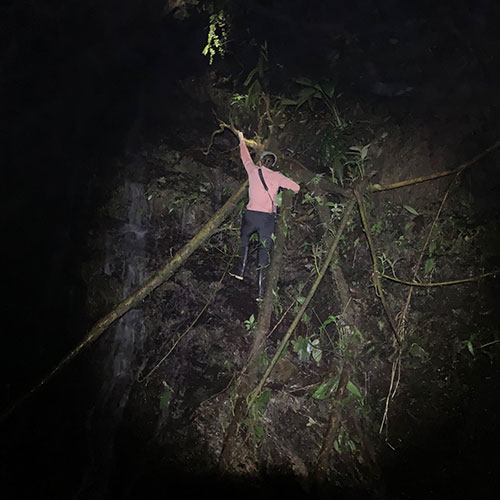A species of Ecuadorian glass frog combines high-frequency croaking and a striking visual display to attract mates, in what is a fascinating adaptation to a noisy environment.
Frogs typically use their iconic croaks to get noticed, but these vocalisations can’t compete with loud sounds that exist in certain environments, such as near crashing waterfalls. As a result, some species of frogs have evolved a supplemental advertising technique in the form of long-distance visual displays.
New research published in Behaviour documents the first known instance of this two-pronged strategy in the glass frog family, specifically in Sachatamia orejuela, a species native to Ecuador and Columbia. This strategy has also been documented in frogs living in India, Borneo, and Brazil.
“A handful of other frog species around the world use visual signalling, in addition to high-pitched calls, to communicate in really loud environments,” Rebecca Brunner, a Ph.D. student at UC Berkeley and the first author of the new paper, explained in a press release. “What’s interesting is that these species are not closely related to each other, which means that these behaviours likely evolved independently, but in response to similar environments — a concept called convergent evolution.”
Glass frogs tend to be lime green, but the skin surrounding their abdomens is practically transparent, making their internal organs visible (hence their name). Members of Sachatamia orejuela prefer to hang out on rocks and boulders inside the spray zone of waterfalls. This may not seem a very pleasant place to live, but these wet, slippery rocks offer good protection from predators. Here, the glass frogs are also excellently camouflaged, with their lime green and translucent skin.
Scientists don’t know much about Sachatamia orejuela, or other glass frogs for that matter, prompting Brunner, a conservation ecologist, to visit an Ecuadorian rainforest in an effort to catalogue their mating calls, which had never been done before.

That no one had bothered to record the mating calls of this species is hardly, surprising given its environment. To record these calls, Brunner had to wade through a rainforest stream in waters that ran nearly up to her neck. For this valiant effort she was duly rewarded, as she managed to record their distinctive vocalisations. An ensuing analysis showed that Sachatamia orejuela produces a mating call at higher frequencies compared to other glass frog species. This is hardly a coincidence, as high frequencies can pierce through low rumbling sounds. This is a beautiful example of a species adapting to its environment.
As Brunner was recording these sounds, however, she stumbled upon something she and her colleagues didn’t expect. The male frogs were making rapid-fire hand-waving motions, accompanied by some flashing of feet and the occasional head-bob. Intrigued, Brunner captured video of the behaviour.
“I was already over the moon because I had finally found a calling male after months of searching,” she said. “Before our publication, there was no official record of this species’ call, and basic information like that is really important for conservation. But then I saw it start doing these little waves, and I knew that I was observing something even more special.”
Importantly, this wasn’t a one-off. Brunner also observed a nearby male performing the exact same dance. Together, the high-pitched mating call plus the physical gesticulations likely increase the ability of these frogs to get noticed, according to the new research.
[referenced id=”1222514″ url=”https://gizmodo.com.au/2020/06/8-wild-examples-of-evolution-copying-itself/” thumb=”https://gizmodo.com.au/wp-content/uploads/2020/06/12/bm0ioas5jvqxkopwn0d0-300×169.png” title=”8 Wild Examples of Evolution Copying Itself” excerpt=”Every once in a while, Darwinian natural selection stumbles upon the same solution more than once, in a process known as convergent evolution. Here are our favourite examples of evolution making the same creature, or same physical trait, twice.”]
“One of the best things about fieldwork is that nature is always full of surprises — you never know what discoveries you may happen upon,” said Brunner. “I hope our findings can serve as a reminder that we share this planet with incredible biodiversity. Conserving ecosystems that support species like Sachatamia orejuela is important not only for our well-being, but also for our sense of wonder.”
Super cool, but I’d very much like to know if the females respond by swiping their hands to the left or to the right. Perhaps something for a future study to sort out.
